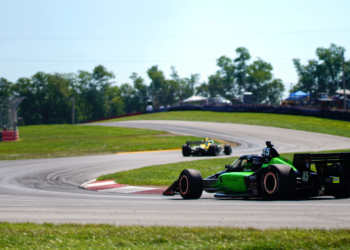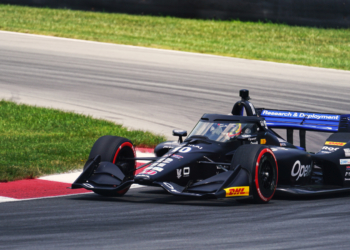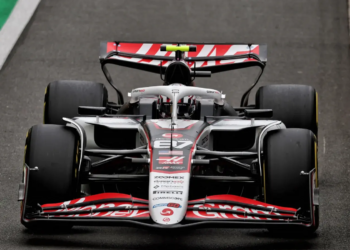Fernando Alonso may be stealing a lot of focus ahead of his Indianapolis 500 debut, but there’s another rookie within the Andretti squad who is looking to make an impression: British driver Jack Harvey.
Following on from impressive stints in Formula BMW, British Formula 3 – he was crowned champion in 2012 – and GP3, Harvey decided to make the move over to America for the 2014 season and joined the Indy Lights grid.
Harvey stayed in the IndyCar feeder category for two seasons and finished runner-up both times, but couldn’t secure a drive for 2016 – although there was a slim chance of an IndyCar seat. However, a lot of hard work and determination has rewarded Harvey with an Indy 500 drive this year.
The 24-year-old has joined frontrunners and reigning Indy 500 champions Andretti Autosport, in collaboration with Michael Shank Racing. A steering column failure resulted in a far from ideal start to his Month of May but Harvey feels confident and comfortable ahead of his debut.
He caught up with Motorsport Week’s Jack Leslie ahead of second practice for the Indy 500 to discuss his switch to America and aims for the iconic oval race.

Jack Leslie: People in Europe will be familiar with your racing over there, what sparked the switch to the US?
Jack Harvey: “I think, honestly, the reason for coming to America was that Formula 1 was bottlenecking, the junior formulas were bottlenecking. People were, sort of, plateauing and stagnating. I came to America at the end of 2013 to check it out and felt there were some good opportunities out here, still for a lot of money but certainly a lot less [than in Europe]. The way the Mazda Road to Indy works is, if you win the championship it can promote you into the next category. Although I was unfortunate to be second both years in Indy Lights I think the system works. I certainly felt as a career move it could lead to something more long-term and I still believe that now.”
JL: How was the transition from racing in Europe compared to the US?
JH: “Good, actually. I feel like Europe prepared me pretty well for coming out here, honestly. I have quite a bit of experience now in the lower formulas, obviously working to try and race at IndyCar level full-time or at least a lot more regularly. I feel the transition and things I was used to in Europe fared me well here, there are some differences obviously – the circuits are a little more tight and twisty, bumpier, a wider variety with ovals, street circuits and road courses. The variety is higher and it still feels pure. In F1, there are such massive differences between cars with engines and whatnot. Over here, in IndyCar, it is somewhat of a spec series – everyone gets the same Dallara chassis and the only difference is whether you run a Chevrolet or Honda engine, and the bodykit to match each engine. I feel like if you hit your day well, everybody has an opportunity to win and that’s something you can’t say about F1.
Of course, you’ve got the Indy 500 coming up, which is pretty big… how did that deal come about?
JH: “We’ve been working on this for 18 months or so, there was a slight chance to get in a car last year. We just couldn’t quite make it happen in time, so after that we looked at what we could do and what we had, in the end we made the decision to not do any single event races other than the Indy 500. It is something we could sell to sponsors and it’s the biggest race of the year. I don’t know what we are going to do post-Indy, we will work with our sponsors and see what they want to do. Honestly, it came about through a lot of hard work in what was difficult circumstances. When we got the deal signed it was a sense of excitement, relief, a weight off my shoulders. On the flip side, you feel like because it’s happening there’s more pressure. Because it’s not something you’re dreaming about anymore, it’s actually happening. It’s difficult to really sum up.”

JL: What are your thoughts on Alonso being your team-mate?
JH: “So random and crazy, and awesome. It’s a situation I never expected myself to be in, especially as he was a childhood hero of mine. It’s pretty bizarre and it’s been a pretty cool experience so far. He’s been a super nice guy and I’m just excited to keep learning from him.”
JL: We’ve seen a lot about the Rookie Orientation Programme recently, for people not familiar, what does that include?
JH: “Basically, it’s to be able to show the Speedway you can control the car at different speeds. The first phase is 205mph to 210, second is 210mph to 215 and phase three is 215mph upwards. It’s more to show them you can control the car, we are trying to get our phase finished. We had a couple of issues yesterday [Monday]. One scary one [the crash], which the team has taken full responsibility failure for. We had the steering column come apart, which was pretty nerve-wracking. But the amount of people on my car trying to fix everything is a good sign that it is going to be as safe as it can be and ready to go today [Tuesday].
JL: Are you all OK, no aches or pains?
JH: “No, nothing like that. I was only coming out of the pits so it happened at a relatively slow speed. But I don’t want anything like that to happen again, that’s for sure.”
JL: You’ve already been on track for Indy 500 practice, how did the car feel?
JH: “I felt super comfortable, I was pretty happy with everything. I was just looking forward to getting out and getting in a few more laps than we did, but we have time today [Tuesday] and the rest of the week to make up for it. I did feel comfortable which I was happy about and hopefully we have got rid of some of those teething problems to try again.”

JL: As you’ve raced at the Indianapolis Motor Speedway before…
JH: “Yeah, I did the Indy Lights and won the Freedom 100 on Carb Day. I know I can get around here OK and it’s a track I feel I have gone well at before. I’m optimistic we can have a good month.”
JL: With that experience and there being such a long period of practice, do you think that makes the race more accessible for rookie drivers?
JH: “For sure, you get so much more track time. You can never beat time just purely on track and that was another reason for doing the Indy 500, as opposed to other races where you may get an hour on track before qualifying. Here, you get six hours available every day for… I can’t remember how many days. It’s 30 hours of track time before qualifying and then another full day after that, so there’s plenty of time on track and I think that’s why you see a lot of rookies doing the Indy 500.”
JL: What are your aims for your first Indy 500?
“I think we’d like to be Rookie of the Year, that’s the goal for all rookies I think. If we were in the top 10 at the end of the day that would be a fantastic result. If you aare in the top 10, other things could happen and somewhere in that region could would be a really strong day in the office.”
JL: The Indy 500 can be so unpredictable too…
JH: “It definitely can be and that’s what is exciting about it. You never know what is going to happen and if you are on the lead lap with 30 or 40 laps to go, anything is possible. As long as we are still there by the end of the race we should be fine.”
JL: Looking beyond that, what are your hopes for racing in the next few seasons?
JH: “It totally depends on sponsorship, would I like a to [be in IndyCar]? Yes, of course. Do I think it is possible? I think it’s possible, but I just want to be back in a car full time really. Whatever that is, the single event weekends are tough, I know Indy is not just over a weekend but a month but I’d like to be back in a full-time drive. Hopefully it could be in IndyCar but if not, I just want to be sure I am getting to drive something.”






